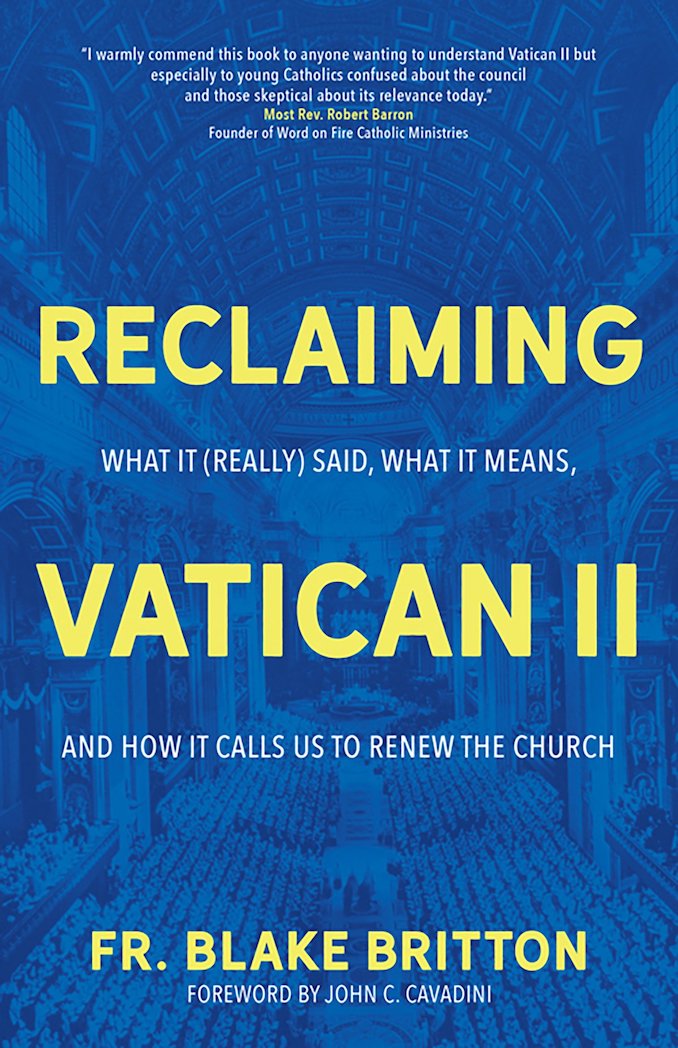“Reclaiming Vatican II: What It (Really) Said, What It Means and How It Calls Us to Renew the Church” by Father Blake Britton. Ave Maria Press (Notre Dame, Indiana, 2021). 191 pp. $17.95.
The subtitle of this book about the Second Vatican Council could well be “To the Rear March but with Small Steps.” Or “Vatican II Lite.”
It stresses Church traditions upheld and elaborated upon by the 1962-65 ecumenical council while downplaying the importance of council’s reforms — such as the vernacular in the liturgy — which were approved as part of a major effort to make Catholic teachings and rites more intelligible to modern Catholics and the world at large.
The book is reminiscent of talks and public statements given in the 1980s and 1990s by Cardinal Joseph Ratzinger, who became Pope Benedict XVI, when he was prefect of the Vatican’s Congregation for the Doctrine of the Faith.
These became known as “Ratzinger’s restoration,” a reference to the historical movement that restored many monarchies in 19th-century Europe after the political turmoil sparked by the French Revolution.
The aim, then and now, is to slowly roll back the reforms by emphasizing the traditional.
Father Blake Britton, author of “Reclaiming Vatican II,” dedicates the book to retired Pope Benedict. The author is a parish priest in the Diocese of Orlando, Florida. He has appeared on EWTN and is a regular contributor to the Word on Fire Institute’s blog and journal.
His book tries to influence millennials and other Catholics far removed in years from the events of the Second Vatican Council and the debates that shaped its documents.
His restoration affirms that what many Catholics regard as council teachings are really the result of a “paracouncil”: false interpretations by a triumvirate of disgruntled theologians, the media and the catastrophic events of the times as varied as the sexual revolution and the assassination of President John F. Kennedy.
The theory posits: Many theologians interpreted according to their own liberal liking rather than according to the council’s texts; then as now the media engaged in “fake news;” and the catastrophic events of the 1960s resulted in a lack of respect for authority.
The author’s bottom line is: Today’s Catholics are inheriting misinterpretations.
Obviously, there were misinterpretations — honest and otherwise — and some erroneous reporting. But this view is painting with a very broad brush.
Almost 60 years after the council, a lot of the wheat has been separated from the chaff. Also, there are many official Church documents instructing how to apply Vatican II.
The book focuses on the four main council documents: the constitutions on the liturgy, the Church, divine revelation and the Church in the modern world.
The author knowledgeably discusses the Church traditions maintained, especially Latin in the liturgy as a sign of unity. He suggests that its liturgical use should be expanded. He fails to mention that Latin derived its liturgical importance because it was once the vernacular language.
Not discussed are important and groundbreaking decrees such as the one on religious liberty, which said this freedom resides in the person and must be respected for all believers by the Church and civil society.
There is also the decree on relations with non-Christian religions, which states clearly that neither all the Jews at the time of Christ nor all the Jews of today are responsible for Christ’s death.
Let’s not forget the decree on ecumenism, which sees dialogue with other Christian religions as a valid form of seeking Christian unity.
We do learn, however, that applauding the priest after his Mass homily is not a liturgical requirement.
Rather than reclaiming Vatican II, this book is an effort to reshape its image.
Bono is a retired CNS staff writer.

